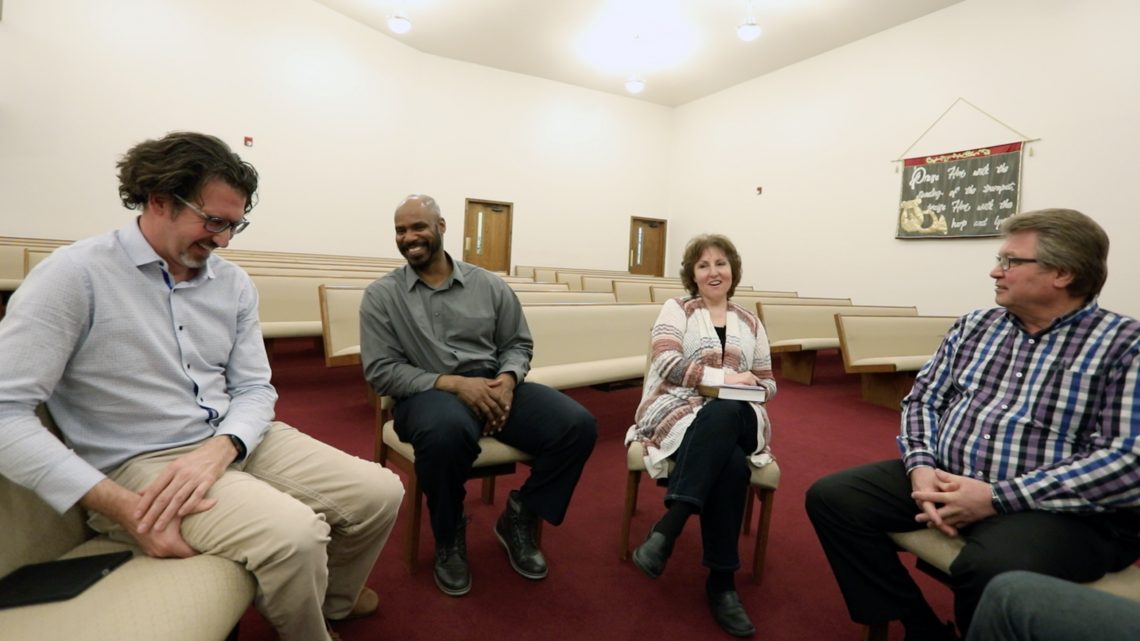How do the standards that we attach to what a healthy church should be measure up to a realistic church journey? We sat down with the elders and senior pastor of the Sioux Falls, South Dakota church and embarked on a candid, deeply reflective round-table conversation.
The Church: Hovering around the 300-member mark, the church is located just East of Sioux Falls, managing a radio station and a school with 8 students (one of which is graduating at the end of this school year). A decent percentage of the regular attendance drives in from 35-45 miles away, which can impact activities the church plans. Uniquely for South Dakota, Sioux Falls and the church are fairly ethnically diverse.
The panel: Chad Spanos, elder; Mart Blackburn, elder; Colette Dawes, head elder; Larry Christensen, elder; and Dragos Profir, senior pastor.
Mark Blackburn: I think a healthy church is one that has great community: we feel like we belong here. I can come here and know that my kids will looked after. We have a lot of people that care for one another. There’s a genuine people here, it’s more than just “church on Sabbath.”
Collette Dawes: A healthy church is one where everybody feels safe; safe to worship, safe to speak with one another. A place where you feel safe.
Larry Christensen: It’s important to be aware of our problems to be a healthy church. We are looking for a more complete and better picture of what God is like. As we know God better it’s a law that we become like the God we worship and admire.
Dawes: We are working on becoming healthy here, and the healthier we are inside the more work we can do in the community.
Pablo Colindres Moreno: Like a magnet effect. How does that fit into the mission of your church?
Chad Spanos: I think it’s critical. If you do not have a home base, a safe space (he motions at Collette), it doesn’t work. You can reach people outside, but if you invite them in and it doesn’t feel safe it doesn’t work. People are always questioning, but do you have an environment where people are able to find truth, understand and question.
Dragos Profir: Our purpose is to help people on their life’s journey to grow closer to God. A “one-size fits all” is not going to work. We want to grow closer to God and bring others along, through various methods. The biggest challenge we face is putting us out there. For example, advertising to the community so that they can consider our school as an option for their children.
Colindres: Okay, let’s talk about the challenges.
Blackburn: From my perspective, some people gauge their expectations on the demographics of the city. We’re growing, and we’re retaining individuals, but the perception of a small church in a small town is “you should be able to do everything,” which isn’t true.
Colindres: You’ve got every person wearing multiple hats.
Blackburn: Right. Like what Chad said, we have a great nucleus here, and we’re starting to build on that.
Dawes: Even though we feel like it’s a warm, inviting place, there’s always people that might feel like they fall through the cracks. Those are the places where, when we hear about it, we strive to be better and strive to make ways bring healing.
Colindres: Our theme this year at the OUTLOOK is “Building the Body of Christ.” I like to think that means “Building Community.” How is your church doing that?
Profir: To me, the most amazing thing is when a Sabbath school group has a hard time ending their study in time for worship or people the fellowship in the Sanctuary long after worship—because there is community, that is community. Church here doesn’t end at 12, 12:30.
Spanos: I think the most exciting recently is when we have activities or programs that don’t work out like we planned them, but surprising people stepped up and are starting to run programs in their own way. We may have ideas of who should do what, but that can limit people. Maybe we haven’t quite hit on what works right for the city, or those that think differently from us.
Dawes: I think this is where we struggle. As the gentlemen have been saying, we have a wide range of population, age and ethnic diversity. It’s hard to find the groups that target different communities, and what programs should be.
Colindres: And that looks different for every church, every community.
Christensen: I think the key to outreach is not necessarily making Adventists out of everybody, but can we help them be better children of God. Being willing to help people see who God is, and let them work it out needs to be a goal of ours.
Colindres: What about this church keeps you coming back, and what gives you hope?
Blackburn: I like to say Excellence is a habit, not an action. Here, the warmth and welcoming environment has led some of my secular friends to start attending, out of the blue, but it’s because of this habit this church has.
Spanos: I like to come here because I am constantly challenged. I have to dig open my Bible and think and study, and that challenge I receive every week tells me this is a healthy church.
[the panel grows quiet for a second. Dawes and Christensen whisper about the comfort palpable in the church.]
Profir: Going back to the theme of safe, like the cities of refuge in the Bible. A church of safety, of hope. God brought us here not out of what we can bring, but because this is home. The congregation is in good hands because of everyone that is here.
Colindres: Anybody else?
Christensen: Well, I think everyone’s covered everything.










